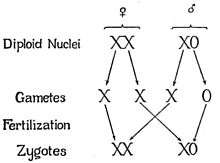X0 sex-determination system

The X0 sex-determination system is a system that determines the sex of offspring among:
- most arachnids[1] with the exception of mites where a small majority are haplodiploid,[2]
- almost all apterygote and Paleopteran insects (e.g. dragonflies and silverfish)
- most exopterygote insects, (e.g. grasshoppers, crickets and cockroaches)
- some nematodes,[1] crustaceans,[1] gastropod molluscs[3] and bony fish,[4] notably in the genus Ancistrus.[5]
In this system, there is only one sex chromosome, referred to as X. Males only have one X chromosome (X0), while females have two (XX). The zero (sometimes, the letter O) signifies the lack of a second X. Maternal gametes always contain an X chromosome, so the sex of the animals’ offspring depends on whether a sex chromosome is present in the male gamete. Its sperm normally contain either one X chromosome or no sex chromosomes at all.
In a variant of this system, most individuals have two sex chromosomes (XX) and are hermaphroditic, producing both eggs and sperm with which they can fertilize themselves, while rare individuals are male and have only one sex chromosome (X0). The model organism Caenorhabditis elegans—a nematode frequently used in biological research—is one such organism.
Some Drosophila species have X0 males.[6] These are thought to arise via the loss of the Y chromosome.
Parthenogenesis
Parthenogenesis with X0 sex-determination can occur by different mechanisms to produce either male or female offspring.[7]
In humans
In humans, having only a single X chromosome is known as Turner syndrome. However, such individuals generally present as female, as humans have an XY sex-determination system.
References
- 1 2 3 Bull, James J.; Evolution of sex determining mechanisms; p. 17 ISBN 0805304002
- ↑ Bachtrog, Doris; Mank, Judith E.; Peichel, Catherine L.; Kirkpatrick, Mark; Otto, Sarah P.; Ashman, Tia-Lynn; Hahn, Matthew W.; Kitano, Jun; Mayrose, Itay; Ming, Ray; Perrin, Nicolas; Ross, Laura; Valenzuela, Nicole; Vamosi, Jana C. and The Tree of Sex Consortium; ‘Sex Determination: Why So Many Ways of Doing It?’; PLoS Biol12(7): e1001899
- ↑ Thirot-Quiévreux, Catherine; ‘Advances in Chromosomal Studies of Gastropod Molluscs’; Journal of Molluscan Studies, vol. 69 (2003), pp. 187-201
- ↑ Devlin, R.H. and Y. Nagahama, 2002. ‘Sex determination and sex differentiation in fish: an overview of genetic, physiological, and environmental influences’; Aquaculture 208: 191–364.
- ↑ Anderson, Luís Alves; Oliveira, Claudio; Nirchio, Mauro; Granado, Ángel and Foresti, Fausto; ‘Karyotypic relationships among the tribes of Hypostominae (Siluriformes: Loricariidae) with description of XO sex chromosome system in a Neotropical fish species’; Genetica, vol. 128 (2006); pp. 1-9
- ↑ Patterson, J. T.; Stone, W. S. (1952). Evolution in the Genus Drosophila. New York: Macmillan.
- ↑ Hales, Dinah F.; Alex C. C. Wilson; Mathew A. Sloane; Jean-Christophe Simon; Jean-François Legallic; Paul Sunnucks (2002). "Lack of Detectable Genetic Recombination on the X Chromosome During the Parthenogenetic Production of Female and Male Aphids". Genetics Research. 79 (03): 203–209. doi:10.1017/S0016672302005657.